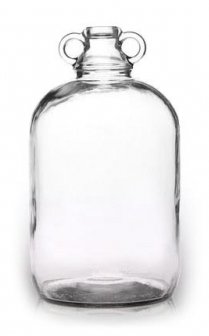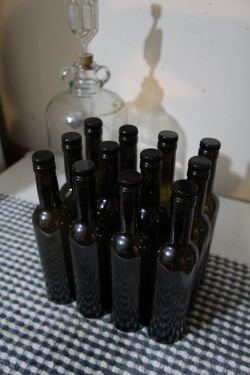Mead
Here follow notes I took while attempting my first batch of mead, after deriving an "average" recipe and method from the Internets.
Equipment
You will need:
- a one gallon (4.5 litre) demijohn and cork
- a blooper (S-bend air lock)
- a hydrometer
- a sink full of hot soapy water
- bleach
- a bucket
- a large metal skillet with lid
- a whisk
- a funnel
- a small empty glass bottle or jar
- clean sterile bottles (a few weeks later)
Ingredients
- 4.5 litres of water
- approximately 1.1 kg honey
- 1 lemon
- wine yeast
Preparation
Make the blooper cork
If the cork for the demijohn doesn't already have a hole in it for the blooper, drill a hole vertically through the top, slightly smaller than the diameter of the blooper tube, so it fits tightly. Seal it up with a bit of beeswax if necessary.
Sterilise
Fill the demijohn with hot water and add 1 tsp of bleach. Leave it to sit for a bit while washing up all the other equipment in hot soapy water and rinsing to remove traces of soap. Give the demijohn a shake and then pour out the bleachy water into a clean bucket to reserve for sterilising any implements as needed. Rinse and shake the demijohn several times with plenty of water to remove all traces of bleach. Seal with the blooper cork to keep sterile, prime the air lock with a small amount of water, and set the now sterile demijohn aside.
Method
Starting the brew
Measure 4.5 litres of water into the large clean skillet, bring to the boil, and leave to cool with the lid on. This is to reduce oxygenation and minimise natural airborne microbes, and may take an hour or two. When the temperature has dropped to just above blood-warm (about 40°C) add the juice of a lemon and about 1100 g of honey (see Calculations below) and stir gently to dissolve using a whisk, taking care not to unnecessarily aerate the brew by disturbing the water surface. Using the funnel, pour the brew into the demijohn, reserving ¼ cup into a small sterilised bottle.
When the brew in the small bottle has cooled to luke-warm (about 25°C), add the wine yeast, seal and shake well, and leave for 10 minutes to activate. Once the demijohn has cooled to ambient temperature, shake the yeast mixture again and pour it into the brew. Re-cork the demijohn and swirl gently to mix.
Brewing
Leave for 4-6 weeks in a place that has a steady temperature, ideally 26°C which is slightly above ambient room temperature, and out of direct light. This might be simply wrapping a blanket around it and stashing it in a cupboard, or putting it next to the hot water cylinder. Yeast will die in hot weather, so do not exceed 40°C. Room temperature or below is also fine, but it will simply take longer. My brew was averaging 18°C and took 9 weeks.
Decanting, settling and ageing
Once the yeast has stopped and settled out, the SG should have hopefully reached about 1005. Gently decant the finished brew into another sterilised demijohn, taking care not to disturb or include any sediment. Although the sediment yeast can be saved and reused in future batches, it can eventually become contaminated with unwanted microbes which spoil brews.
Fining is the addition of "finings" (some form of colloid) to a cloudy brew, in order to help settle out the very fine particulates, leaving behind a crystal clear liquid. There are many different types of finings, but simple gelatin works well enough. For a gallon of mead, add ¼ teaspoon of gelatin to about 3 tablespoons of hot water, and stir until dissolved, then tip into the decanted brew and stir gently. Leave for 2-3 days.
With this decanted brew, we may like to do several things:
- Add oak shavings, to "age" the brew, tasting daily for a buttery smoothness. This could be fun as I have no idea what it should taste like. This will also give it something to develop while it sits around in bottles for months.
- Infuse with a careful selection of herbs to make absinthe - e.g. lavender, mugwort, wormwood or other.
Bottling
Bottle once the SG is under 1005 by siphoning from the demijohn directly into clean sterile bottles. Affix label, and store ideally for at least 6 months; mead greatly improves with age.
Freeze distillation
Particularly if one has made mead absinthe, it can be repeatedly frozen and the ice removed until a liqueur has formed, which should roughly double the alcohol percentage.
Calculations
The percentage alcohol at which the yeast dies will determine the starting specific gravity (SG) of the brew, as measured by the hydrometer. If the hydrometer is nifty, it will have scales which tell you what your starting SG should be for a given final alcohol percentage, and how much sugar per litre you need. Commonly available wine yeast dies at about 12%, for which you need a starting SG of 1.09 g/cm³, achieved by adding 200g of sugar per litre. To produce 4.5 litres at 1.09 g/cm³ we need to add 900g of sugar. Since honey is about 80% sugar, we need 1125 g of honey.
Comments
Yeast consumes glucose and other sugars to produce carbon dioxide, which is released through the one-way blooper air lock, and alcohol. As the alcohol content rises, the yeast will eventually "finish", where it dies at a certain alcohol threshold. Different yeasts have different alcohol tolerance: ordinary baking yeast about 3 percent, beer yeasts 5 to 8 percent, and wine yeasts 12 to 15 percent. Very generally, if the yeast is killed before all the sugar has been consumed, the resulting brew will be sweet. On the other hand, if the sugar in the brew depletes before the yeast dies from alcohol, the brew will be dry. Sometimes this is deliberate, since adding a small amount of sugar during bottling will re-awaken the yeast in the bottle, producing more CO₂ in the bottle, and result in a sparkling wine, or beer with a "head", and hopefully not a basement coated in sticky brew residue and full of broken glass.
Resources
- Wikipedia. The Brewing article.
- Epicurious. "Basic mead recipe".
- gotmead.com
- Brewers Coop and The Brew Shop - New Zealand online brewing supplies.

